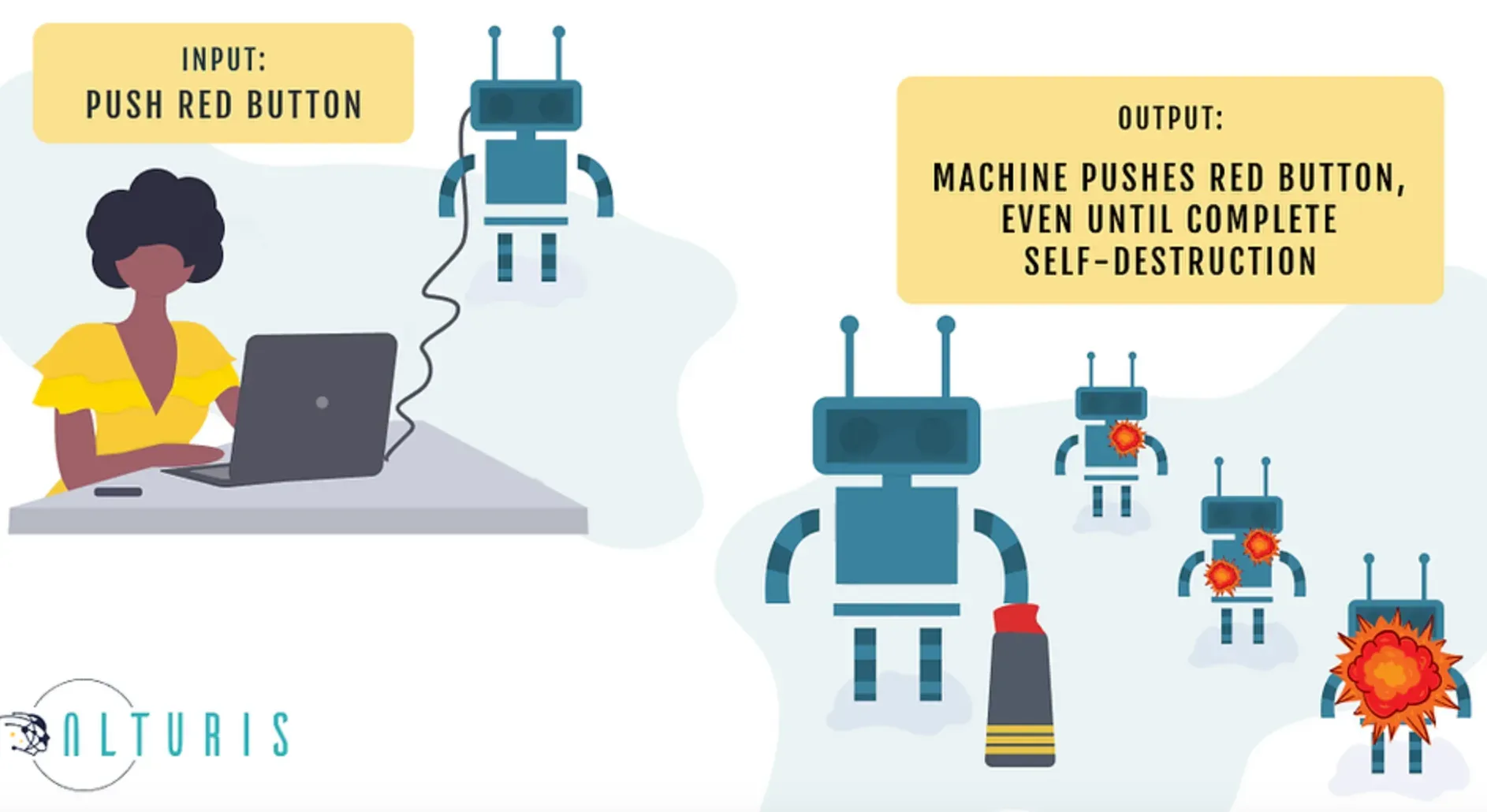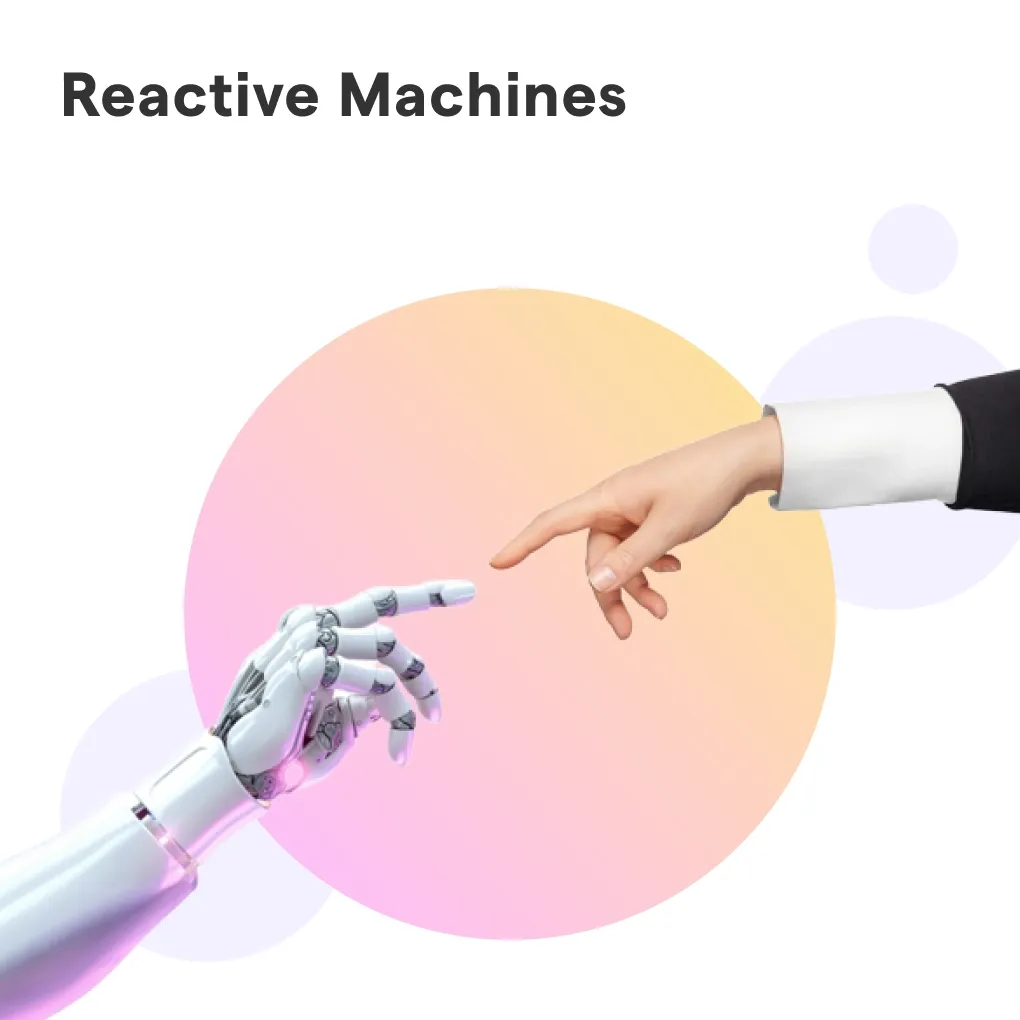Introduction to Reactive Machines
Reactive machines have a few telltale signs. They’re consistent; like a perfectly tossed dosa, they do the same thing every time.
They’re pretty fast, But, they don’t learn or remember. Same stimulus, same response, every single time.
The "Reactive" Aspect
What makes these machines reactive is their direct mapping from input to output. It’s like ringing a bell to get the waiter’s attention—ring equals action.
The Present Focus
These machines live in the now, with no storage for past experiences or data. They don’t hold grudges or have favorite days; every interaction is a new, standalone event.
Limitations
Reactive machines are limited by their lack of memory. They can’t use past experiences to inform current decisions, which is why they’re super reliable for repetitive tasks but not great for anything that requires learning or adapting.
How Do Reactive Machines Work?
Peeling back the layers, it’s time to see just how these mechanical onions work.
They’re all about circuits and predefined rules, responding with programmed reflexes to any input they get.
Input-Output Relationships
Think of reactive machines as a simple cause-effect relationship.
They get input, like pressing a button, and boom, out comes a reaction, like your auto-rickshaw’s meter starting.
Internal Mechanisms
Inside, they're a tangled web of circuits or code that instantly dictates the response to certain inputs, much like flipping a light switch on and off.
Sensory Inputs
Reactive machines often have sensors, like in a car’s parking assist, where they detect objects nearby and tell the car when to beep more urgently. No thought, just action.
Deterministic Nature
Every single response is predetermined. No guesswork here; it’s like knowing that your pressure cooker will whistle exactly after three minis on high heat.
Speed of Response
Thanks to their simplicity, reactive machines react with speed. No daydreaming or contemplation, just a straight sprint from input to action.
Why Use Reactive Machines?
So, why even bother with these machines? Because sometimes, you just need a simple tool for a simple job—no frills, no fuss.
Reliability
They’re predictable. You can bet your last samosa that they’ll do exactly what they’re supposed to do every time, much like your trusty old ceiling fan.
Consistency
Reactive machines are consistent, like the tiffin service that delivers the same amount of dal with your meal daily.
Simplicity
These machines are simple, making them easy to use and maintain—kind of like a well-loved bicycle that just needs the occasional oiling.
Cost-Effectiveness
No high-level computations mean lower costs—both in making and running them. It's like preferring a basic phone over a smartphone when you only need to make calls.
Efficiency in Repetitive Tasks
For repetitive, routine tasks, like scanning barcodes at a store, reactive machines are perfect. They keep going, never tiring or getting bored.
Who Benefits from Reactive Machines?
The use of reactive machines spans a wide assortment of fields, helping those who need actions done quickly and without error – think of them as the dependable sort who show up and get things done without any drama.

Manufacturing Industry
Factories love them. Like automated assembly arms, they do the same weld, cut, or fit, over and over—never complaining, never asking for chai breaks.
Consumer Electronics
Your washing machine is a prime example. Choose a cycle, and off it goes, splishing and splashing, getting your clothes clean exactly the same way, every time.
Medical Field
In surgeries, tools that cauterize or cut based on specific inputs help doctors focus on the complex stuff, knowing the simple jobs are handled without any hiccups.
Automotive Industry
Cars with sensors that react instantly to air pressure loss or an object too close for comfort keep drivers safe without any extra decision-making needed.
Entertainment
Ever wonder how old video games work? They respond to button presses with designated actions—zap a space invader, jump a mushroom, and so on.
When Do We Need Reactive Machines?
Timing is everything, and there are occasions when reactive machines are just the right fit for the job—quick response, zero learning required.
Immediate Response Required
When you need an instant reaction, like airbags deploying in a crash, reactive machines are your go-to.
Hazardous Environments
In places too dangerous for humans, like deep mining or nuclear reactors, a machine that reliably follows commands without hesitation is invaluable.
Routine Tasks
Tasks that are monotonous and never change cry out for reactive machines, as they can perform the job consistently without rest.
Limited Function
In situations where the task is simple and doesn’t require complex decision-making, like a vending machine dispensing your favorite snack.
Supervised Environments
In settings where humans are always present to intervene if needed, having a reactive machine that does just what it’s told is perfect.
Where Are Reactive Machines Implemented?
Look around, and you’ll find reactive machines in our everyday life. They’re the unsung heroes making operations smoother, safer, and more predictable.

Consumer Products
Home appliances, such as coffee makers and vacuum cleaners, do their designated tasks at the push of a button.
Transportation Systems
Subway doors that open and close at each station or traffic lights that change at fixed intervals are classic examples.
Industrial Automation
Conveyor belts, robotic arms, and all sorts of manufacturing widgets rely on simple if-this-then-that logic to get things made.
Service Industry
Automatic doors or those hand dryers in restrooms that roar to life when they detect your hands—reactive machine wizardry at play.
Emergency Systems
Fire alarms that go off when they sense smoke are doing their job without a hint of learning—reactive, predictable, and potentially life-saving.
Best Practices for Using Reactive Machines
Even though they’re super simple, there are some clever ways to ensure reactive machines do their jobs without a hitch.
Regular Maintenance
Keep 'em in top shape. Regular checkups ensure they respond correctly, like making sure the brakes on your scooter actually stop you when you need them.
Clear Instructions
Make sure the commands are crystal clear. If the machine misinterprets the input, it might not give the desired output. It's like telling your rickshaw driver exactly where you want to go.
Controlled Environment
These machines prefer stable, unchanging conditions. Too much unpredictability and things could go haywire. Keep their workspace as consistent as a grandma’s pickle recipe.
Usage Monitoring
Keep an eye on them, in case a sensor goes bonkers or something gets stuck. It's like watching your chai on the stove to make sure it doesn’t boil over.
Upgrade as Necessary
Sometimes, you need to add a new part or change a setting to keep them doing their job right—like swapping your TV remote batteries so it actually changes channels when you press the button.
Challenges with Reactive Machines
Even the simplest machines have their rainy days. There are a few speed bumps in their otherwise smooth journeys.
Lack of Adaptability
They won’t change or improve over time. If your job evolves or you need something different, the reactive machine won’t be coming with you on that journey.
It’s like a basic calculator—it can’t turn into a graphing one when you suddenly want more features.
Scalability Issues
As your needs grow, these machines might not be able to keep up. It's like when your little family corner store becomes a full-blown supermarket. You'll need more than just a cash tin and a manual ledger.
Dependency on Correct Inputs
Garbage in, garbage out. If the input is wrong, what you get is not going to be any better. It’s akin to putting salt instead of sugar in your tea by mistake.
Environmental Sensitivity
Some can get thrown off by changes around them, like a sensor going nuts if it’s too dusty or wet. It's similar to your mobile acting up because it’s too hot or cold.
Technological Limitations
They can only do what they were made to do. No upgrades or new software can change that. Imagine your annoyance with a phone that can't install the latest apps.
Trends in Reactive Machine Utilization
The world keeps turning, and even in the simple land of reactive machines, new trends keep popping up, pointing to ways they might evolve.
Integration with Smart Systems
Linking them up with smarter systems that can monitor and manage them might make them more effective, kind of like attaching a fitness tracker to your old cycle to get modern health metrics.
Energy Efficiency
Newer models are being designed to consume less power, much like LED bulbs replacing old incandescent ones.
Material Innovations
They might be made with newer, lighter, or more durable materials, improving longevity and efficiency, resembling the switch from heavy glass soda bottles to plastic ones.
AI Monitoring
Using artificial intelligence to keep an eye on reactive machines helps catch issues before they cause trouble, much like a health checkup to prevent future sickness.
Internet of Things (IoT) Connectivity

Connecting these machines to the Internet through IoT technology allows simple tasks to be managed remotely, like turning on your geyser from your phone before you get out of bed.
Significance of Reactive Machines in Everyday Life
Their simplicity makes them incredibly important. Reactive machines do their thing, day in and day out, making our lives easier and more predictable.
Daily Convenience
They’re the behind-the-scenes heroes—think elevators, refrigerators, and air conditioners, making the day-to-day just work without a second thought.
Safety
They contribute to safety systems—like fire sprinklers—that we often take for granted. We live our lives peacefully because these systems are on watch.
Productivity Boost
In businesses, they automate tasks, like a printer churning out papers at the touch of a button, boosting productivity without burning out.
Cost Reduction
They keep costs down by doing simple tasks without error, eliminating waste and the need for do-overs.
Accessibility
These machines make technology accessible to everyone since they are often more affordable and easier to use than their more complicated cousins.
Future Implications of Reactive Machines
As technology zooms forward, reactive machines remind us of the value of simplicity, holding down the fort in a world that’s ever-complicating.
Balance with Advanced Systems
The future will involve a balance of these reliable workhorses with flashier AI systems, keeping the basics running smoothly while the advanced tech handles the high-level stuff.
Role in Automation
Their dependable nature means they will continue to be integral in automated systems, doing the routine work so humans and more advanced AI can take on complex tasks.
Potential in Developing Countries
In developing countries like India, these simple, cost-effective machines could lead to modernization leaps in industry and infrastructure.
Education and Training
As technology evolves, education about reactive machines will be important, training the next generation to maintain and implement them effectively.
Continued Evolution
They’ll keep getting better—faster, more reliable, and even easier to use. The future might hold more sophisticated reactive machines that maintain their simple charm while delivering results more efficiently than ever.
Frequently Asked Questions (FAQs)
How do Reactive Machines Differ from Traditional Computers?
Reactive machines are designed to respond to external inputs with immediate actions, unlike traditional computers that execute pre-defined algorithms to process data.
Can Reactive Machines Learn from Past Experiences?
No, reactive machines lack memory components for learning; they operate based on preset rules and immediate inputs only.
What's a common example of a Reactive Machine in everyday life?
Autonomous vehicles using sensors to avoid obstacles in real-time are everyday examples of reactive machines.
Do Reactive Machines use Artificial Intelligence?
Yes, many reactive machines use AI, especially for pattern recognition and responding to environmental changes, though their AI lacks learning capability.
How do Reactive Machines impact Human-Machine Interaction?
Reactive machines improve human-machine interaction by providing instantaneous responses to human actions, enhancing user experience in interactive applications.

